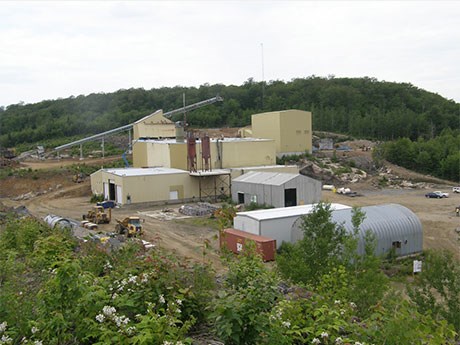Largest confirmed graphite mineral resource in North America Keaney Mine manager Jerry Janik
Hockey players could soon be shooting and scoring using sticks made of graphite mined in Kearney, Ontario. But Ontario G r a p h i t e Mine manager Jerry Janik can’t promise his company’s product will help the Toronto Maple Leafs win the Stanley Cup.
“I wouldn’t go that far,” said Janik, a graduate of geology and mineral processing programs at Sir Sandford Fleming College. With more than 20 years of mining experience, Janik left Texas, where he was area operations manager for Carmeuse Industrial Sand, and returned to Ontario about two years ago to help rebuild the graphite mine 63 kilometres south of North Bay.
He’s been working to revive an open pit mine that operated near the western boundary of Algonquin Park from 1989 until 1994, when a lack of financing and low graphite prices forced it to close. In May, Ontario Graphite Ltd., a privately owned company, received Ministry of the Environment approval for all the necessary permits to operate the mine.
Twenty-one full-time employees, as well as contractors and mill construction personnel, are now working toward the final construction and commissioning of the mill, expected by the end of November.
“We think that we’ll be able to produce product and ship, if not at the end of December, in early January of 2014,” Janik said. “We are trying to get the first load out by the end of this year.”
DRA Americas Inc., a Toronto-based international engineering company, and Merit Consultants International Inc., a Vancouver-based project and construction management firm, are leading the mill construction phase.
“They’ll stick around to help us with the startup commissioning, if needed,” said Janik. The egg-shaped open pit is roughly 40 metres deep, 100 metres wide and 200 metres long. Over the next seven to 10 years, it’s expected to reach a depth of 100 metres. Miners will drill and blast metamorphic rock to extract the graphite.
“It’s a very hard angular rock which was granite at one time and has been metamorphosed into the type of rock we’re mining now – very hard, very angular, very siliceous,” said Janik. A fleet of Caterpillar equipment, including a 990 front-end loader, a 390 excavator and four 80-tonne, 775 ore trucks will move the ore and waste rock.
Ore will be pulverized in a semiautogenous grinding mill. In a combination of conventional flotation cells and column cells, graphite concentrate will be floated off for secondary grinding for more gangue liberation, followed by additional column cleaning flotation steps, Janik explained.
After thickening, dewatering and drying, graphite concentrate will be screened, sized and bagged in onetonne totes.
Ontario Graphite appointed Michael Corscia as senior vice-president of sales and marketing last September. It plans to sell its product with its own sales department. Some customers will buy graphite directly from the mine site, “but the majority will be sent to a local warehouse in the Huntsville area for storage and then shipment from that location,” said Janik.
The company aims to produce 20,000 tonnes of graphite annually. In June, large flake graphite was selling for $1,400 - $1,500 a tonne.
An excellent conductor of heat and electricity, graphite has great strength and rigidity. It remains stable at high temperatures, has high natural lubricity and is a light reinforcing agent.
Graphite is used in steel making, to line ladles and crucibles that hold molten metal, as a component of bricks that line furnaces, and as an agent to increase the strength of steel.
The mineral is also used in carbon brushes and batteries, castings, brake pads, lubricants and pencils. A growing market for electric and hybrid vehicles is expected to boost demand for flake graphite. \Greater use of carbon reinforced plastics in the aerospace and automotive industries is also expected to require more graphite, as will the manufacture of laptop computers, tablets, cell phones, digital cameras and power tools that use lithium ion batteries.
About 80 full-time employees will be needed to operate the Ontario Graphite mine and mill. Approximately 85 per cent of jobs will be filled by local residents, said Janik.
“For the remaining positions, including geologists, mine planners, mill supervisors, we’re going to require some more specialized experience, so we may have to look to nearby mining towns in the Timmins and Sudbury areas to help round out the team. Our goal is to hire as many qualified local residents as possible and train them, if necessary.”
Janik already has resumes from local residents now working in the Alberta oil sands, in Kirkland Lake and at the Detour Lake gold mine north of Cochrane.
While Janik expects the mine will produce 17,000 tonnes of graphite in its first year of operation, reaching its projected peak production of 20,000 tonnes annually will take a little longer.
“We know commissioning and trouble shooting a mill always takes a lot of time. Therefore, we’re taking a very conservative approach and we’re estimating it’s going to take about eight months to ramp up to that full capacity. We want to make sure we have a high quality and consistent product, so we’re giving it an eight-month ramp up to get to that tonnage.”
The mine life is estimated at 30 years, which should be enough time for the Leafs to win The Cup.


